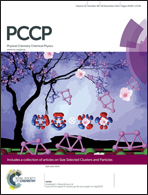Theoretical analysis of electrochemical surface-area loss in supported nanoparticle catalysts
Abstract
In polymer electrolyte fuel cells a decrease in catalytic surface-area within the cathode catalyst layer is a critical barrier to commercialization. This loss in catalytic surface-area manifests as a loss in cell voltage and thus power density of the cell. It has been established that potential cycling accelerates the loss in catalytic surface-area yet isolating the contributing mechanisms as well as relating mechanisms to operating conditions is not as straightforward. We approach the issue of surface-area loss deconvolution with a combined experimental, modelling and theoretical framework. The methodology is based on the Lifshitz–Slyozov–Wagner and Smoluchowski theories of particle size distribution evolution. Electrochemical surface-area loss experiments probing upper potential limits of 0.9 and 1.2 V as well as temperatures from 298 to 343 K were analyzed with the model. A dissolution and redeposition mechanism was correlated with the measurements for both upper potential limits; however, at the upper potential limit of 1.2 V, ambiguity between the coagulation and the dissolution and redeposition mechanisms was found. Notwithstanding, the extracted dissolution and redeposition parameters aligned with independent studies on Pt dissolution whereas similar positive comparisons with independent results were unable to be made for the coagulation mechanism.


 Please wait while we load your content...
Please wait while we load your content...